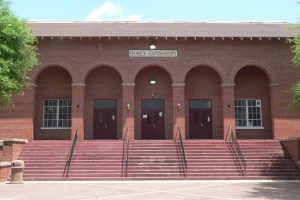 The American history of Orangeburg, South Carolina, stretches back over 300 years to when a man named George Sterling set up a fur trading post in 1704. Thanks to its fertile soils and convenient location on the Edisto River, Orangeburg quickly blossomed into a successful settlement for farming and trade. It’s no wonder that several local locations appear on the National Register of Historic Places (NRHP). Some of Orangeburg’s historic offerings might surprise you.
The American history of Orangeburg, South Carolina, stretches back over 300 years to when a man named George Sterling set up a fur trading post in 1704. Thanks to its fertile soils and convenient location on the Edisto River, Orangeburg quickly blossomed into a successful settlement for farming and trade. It’s no wonder that several local locations appear on the National Register of Historic Places (NRHP). Some of Orangeburg’s historic offerings might surprise you.
Orangeburg County Jail
The imposing architecture of Orangeburg County Jail was crafted in a Gothic design way back in 1857. It took three years to build. A mere five years after its completion, Union troops led by General William T. Sherman torched the building. Its exterior was restored soon after, however.
The building highly resembles a fortress, featuring turrets, towers, and arched, narrow windows. The design was quite fitting, considering its use — many convicts were imprisoned there, and its central tower was where most executions took place. It was inducted into the NRHP in 1973.
All-Star Triangle Bowl
One would hardly expect a bowling alley to make the NRHP, but this historic location — first built in the 1960s — made the list in 1996. Though the bowling alley closed its doors to the public in 2007 due to financial troubles, it still remains on the register. All-Star was the location of the infamous Orangeburg Massacre that took place in 1968 during the Civil Rights Movement.
Unlike most of the integrated public places in town, the privately owned All-Star refused to allow people of color to bowl there. The manager claimed that All-Star was exempt from the laws established in 1964 by the Civil Rights Act. Since there was a snack bar inside, locals claimed that it fell under the terms of the Act and was breaking the law. This sparked a series of protests that culminated in a confrontation at nearby South Carolina State College (SCSC) in which three were killed and 27 were injured.
Dukes Gymnasium
This two-story brick building sits on the SCSC campus and was erected in 1931. It made the NRHP in 1985. It features a five-bay brick arcade in front, a full basement, and a red-tiled gabled roof. It’s framed in steel and has a concrete water table that runs between the first story and the basement.
The buiding is notable for its ties to Miller Whittaker, a groundbreaking African American architect. It was first conceived by John Blanche, an SCSC student of mechanical arts, for his graduate thesis. Whittaker supervised the design, and instructors at the college participated in the construction efforts. It’s still in use today, mostly as offices for the sports department and for intercollegiate women’s volleyball competitions.
With its many historic locations, Orangeburg is a haven for those who love to peer into the past and relive the days of yore. The NRHP is an excellent guide for those who crave this knowledge, and there are literally dozens of locations in the area to choose from. Explore, learn, and enjoy!
Image via Wikimedia Commons by Ammodramus






 Warranties include 10-year/100,000-mile powertrain and 5-year/60,000-mile basic. All warranties and roadside assistance are limited. See retailer for warranty details.
Warranties include 10-year/100,000-mile powertrain and 5-year/60,000-mile basic. All warranties and roadside assistance are limited. See retailer for warranty details.